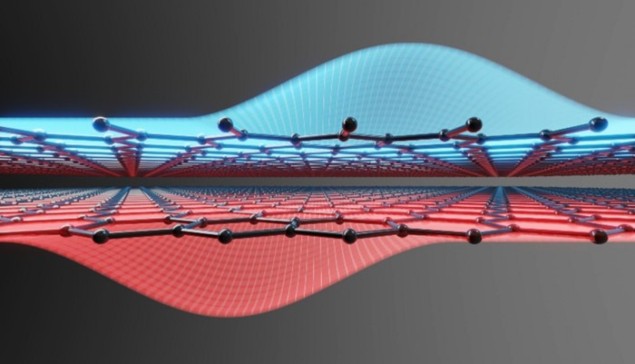Electron-hole symmetry in quantum dots shows promise for quantum computing
11 Jun 2023
Both sides now: artist's impression of bilayer graphene with an electron-hole symmetric double quantum dot, where the electron and the hole are in different layers. (Courtesy: Sebastian Staacks)
Several unique phenomena that could benefit quantum computing have been observed in quantum dots made from bilayer graphene. The research was done by Christoph Stampfer at RWTH Aachen University and colleagues in Germany and Japan, who showed how the structure can host an electron in one layer and a hole in the other. What is more, the quantum spin states of these two entities are near perfect mirrors of each other.
A quantum dot is a tiny piece of semiconductor with electronic properties that are more like an atom than a bulk material. For example, an electron in a quantum dot is excited into a series of quantized energy levels – much like in an atom. This is unlike a conventional solid, in which electrons are excited into a conduction band. This atom-like behaviour can be fine-tuned by adjusting the size and shape of the quantum dot.
A quantum dot can be made using tiny pieces of graphene, which is a sheet of carbon just one atom thick. Such quantum dots can be made of just one sheet of graphene, two sheets (bilayer graphene) or more.
Interesting spin qubits
One promising application of graphene quantum dots is to create quantum bits (qubits) that store quantum information in the spin states of electrons. As Stampfer explains, the development of graphene quantum dots has important implications for the development of quantum computers. “Graphene quantum dots, first recognized in 2007, emerged as interesting hosts for spin qubits, which can employ both electron and hole quantum dots to facilitate long-range coupling,” he says. Holes are particle-like entities that are created in a semiconductors when an electron is excited. “This breakthrough has laid the foundation for a promising quantum computing platform based on solid-state spin qubits,” he adds.
Now, Stampfer and colleagues have pushed the idea further by fabricating quantum dots from bilayer graphene. Here, each graphene layer functions as an individual quantum dot, but closely interacts with its counterpart in the other layer.
Bilayer graphene can trap electrons and holes when an external voltage is applied across them – creating a unique gate structure. Following recent efforts to reduce disorder in bilayer graphene’s molecular structure, Stampfer’s team has now reached a new milestone in this line of research.
Gate tunability
“In 2018, this approach first made it possible to fully utilize the unique electric-field-induced band gap in bilayer graphene to confine single charge carrier,” Stampfer explains. “By further improving the gate tunability, it is now possible to make quantum dot devices that go beyond what can be done in quantum dot materials including silicon, germanium or gallium arsenide.”
A key advantage of bilayer structures are the properties of spin states of the quantum dot’s electrons and holes. Through their experiments, the team discovered that the states of the individual electrons and holes in one of the graphene layers are almost perfectly mirrored in the pair found in the other layer.
“We show that bilayer graphene electron-hole double quantum dots have an almost perfect particle-hole symmetry,” Stampfer continues. “This allows for transport through the creation and annihilation of single electron-hole pairs with opposing quantum numbers.”READ MORE

These results could have important implications for quantum computing systems that use electron-spin qubits. This is because is should be possible to couple such qubits together over longer distances, while reading out their spin symmetrical states more reliably. This could ultimately enable quantum computers to become far more scalable, sophisticated, and resistant to errors than existing designs.
Stampfer’s team also envisage many possible applications beyond quantum computing. predicting how bilayer graphene quantum dots could provide a basis for nanoscale detectors for terahertz waves, and could even be coupled to superconductors to create efficient sources of entangled pairs of particles.
Through their future research, the researchers will now aim to delve deeper into the capabilities of bilayer graphene quantum dots; potentially bringing their widespread application in quantum technologies a step closer.
The research is described in Nature.
Sam Jarman is a science writer based in the UK.
FROM PPHYSICSWORLD.COM 26/7/2023

Δεν υπάρχουν σχόλια:
Δημοσίευση σχολίου